|
Using what you know about switchers
at this point, can you figure out how black arrived on the screen in the
drawing above?
If you moved the fader bars on Effects #2 to the up position,
you would make a transition from black to whatever was on Effects #1. In this case
it would be Camera 2 superimposed over Camera 3.
Finally, let's add some real bells
and whistles. The top row of buttons 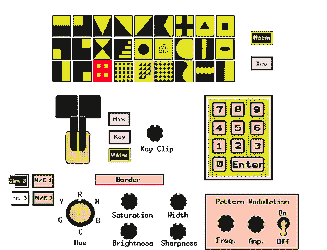 in this drawing represents various types of wipes.
in this drawing represents various types of wipes.
Yellow on the buttons represents one video source, black another
source. Additional patterns-some switchers have hundreds-can be selected by entering
numbers on the keypad.
If wipe is selected on the switcher,
the button pushed (indicated in red in this drawing) shows the moving pattern (controlled
by the fader bars) that would be involved in the transition from one video source
to the other.
A border along the edges of the wipe
pattern-a transition border-can be used, and its hue, brightness,
sharpness, width, and color saturation selected. To add even more variety, the edge
of the wipe can also be modulated (made to move) with the
pattern modulation controls.
The key clip knob controls the video
level of the source you are going to key into background video. This is adjusted
visually on the preview monitor.
Downstream
keyers, which are often used to key in such things as opening titles and
closing credits, are external (downstream from) the 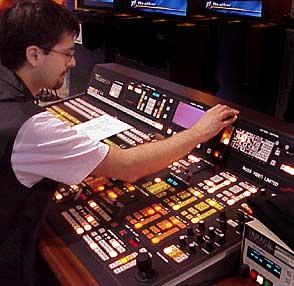 basic
switcher. The advantage of a downstream keyer is that it doesn't require the use
a switcher's effects bank for keying. This means that the bank stays free to be
used for other things. basic
switcher. The advantage of a downstream keyer is that it doesn't require the use
a switcher's effects bank for keying. This means that the bank stays free to be
used for other things.
The switcher shown at the left
incorporates versions of all of the features we've discussed, plus a
computer display that adds
even more options.
Although switcher configurations differ, they all center
around the same basic concepts.
Later, we'll talk about software-based switchers and special
effect units that are based on a desktop computer.
Chroma Key
The type of key we've been discussing
so far is referred to as luminance key because the keying
effect is based on the brightness or luminance of the video that you are keying
in. But, as we saw when we discussed virtual reality sets, it's also possible to
base keying on color (chroma).
In chroma key a particular color is selected
for removal and another video source is substituted in its place. This type of keying
is commonly done during newscasts where a graphic is inserted behind a newscaster,
or a weather map is keyed in behind the weather person.
|
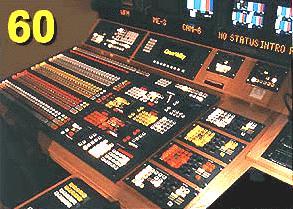
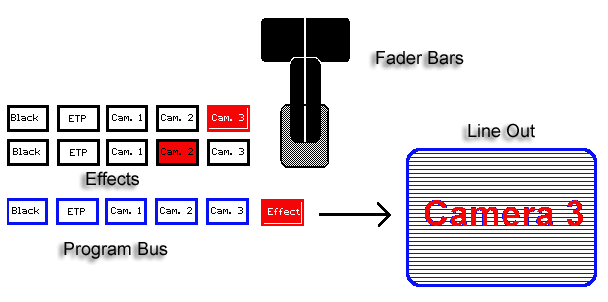
 top to the bottom, we see a dissolve (and overlapping transition)
from camera #3 to camera #2.
top to the bottom, we see a dissolve (and overlapping transition)
from camera #3 to camera #2.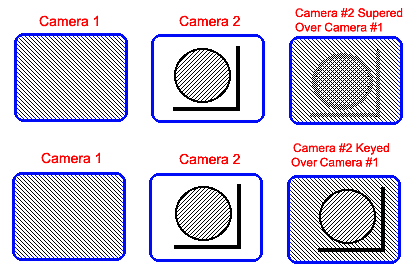
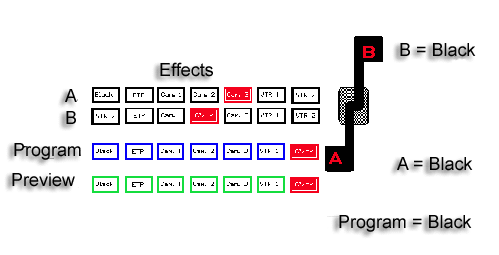
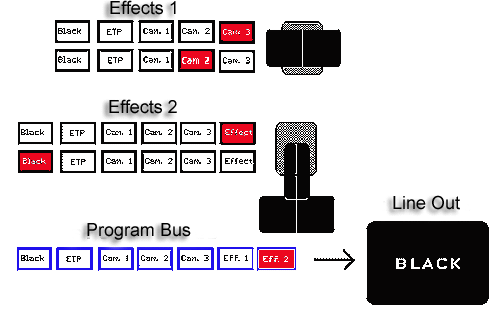
 in this drawing represents various types of wipes.
in this drawing represents various types of wipes. basic
switcher. The advantage of a downstream keyer is that it doesn't require the use
a switcher's effects bank for keying. This means that the bank stays free to be
used for other things.
basic
switcher. The advantage of a downstream keyer is that it doesn't require the use
a switcher's effects bank for keying. This means that the bank stays free to be
used for other things.


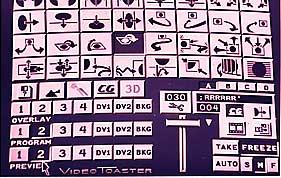 Most
software-based switchers use the hardware-based switcher that we've discussed as
a graphical model. Note the familiar fader bars and the various banks of buttons
shown on the computer screen on the left. In this case, instead of pushing buttons,
you click on the buttons with a mouse.
Most
software-based switchers use the hardware-based switcher that we've discussed as
a graphical model. Note the familiar fader bars and the various banks of buttons
shown on the computer screen on the left. In this case, instead of pushing buttons,
you click on the buttons with a mouse.